Barcelona Hill, mountain and park
One of Barcelona’s most picturesque locations is Montjuic Mountain, which stands at a height of 173 meters and is close to the sea. The vast majority of visitors to the city today, as well as residents, visit it because of the abundance of museums, gardens, viewpoints, sporting venues, tourist attractions, and charms that each of its nooks has to offer. However, it wasn’t always like this because for many years the city and its people ignored the region.
A large part of this disregard, and even the trepidation and fear with which Barcelona residents regarded Montjuc, was brought on by their awareness of what had transpired during times of war, when the city had been attacked from Montjuc Castle, at the summit of the mountain.
Origin of the name ‘Montjuïc”
The most popular explanation for the origin of the name Montjuc is that it derives from the term «Mountain of the Jews,» which refers to the medieval Jewish cemetery that formerly stood on the summit.
Some historians support the idea that the name «Montjuc» actually derives from «Monte Jovis,» alluding to the potential past existence of a Roman temple that was likely devoted to the god Jupiter.
The public’s perception of Montjuc Mountain abruptly changed following the 1929 International Exposition, which is scarcely surprising given the effort that was expended in shaping the mountain into what it is now and earning it the nickname «Montjuc Park» (El Parc de Montjuc).
A further significant event, the celebration of the 1992 Olympic Games, sparked another facelift for the mountain, and as a result, it now appears better than ever. At that point, some of the mountain’s infrastructure and gardens were in risk of being ignored once again.

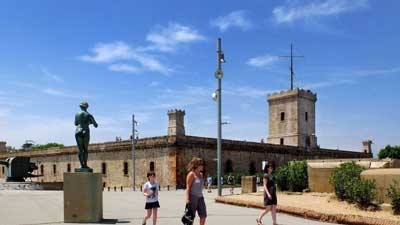
What to see on Montjuïc Mountain
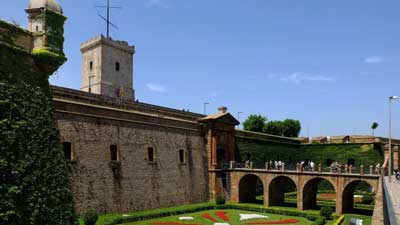
We advise that you schedule a whole day to visit the mountain whenever you can because of the vast array of opportunities it provides. Depending on your preferences, you can decide to spend more time exploring the cultural attractions, concentrating on the breathtaking views from its vantage points, or taking leisurely strolls through its various gardens, which are a must throughout the spring and summer.
Montjuïc’s footprint in Barcelona
Although Montjuc’s historical influence can be seen across Barcelona as well as on the mountain itself, its significance to the city should not be understated.
Because of its qualities, the stone from Montjuc Mountain is a great building material, and the vast majority of historical structures built before the middle of the 20th century used stone from the Montjuc quarry.
Museums and cultural offerings in Montjuïc
The cultural sights that the mountain has to offer compete with those of any other section of the city, even the Ciutat Vella (Old Town), the historical heart of Barcelona. The MNAC (the Museu Nacional d’Art de Catalunya) and the Fundación Miró are the two most significant museums on the mountain, and they account for a significant portion of the interest that has been generated by their presence.
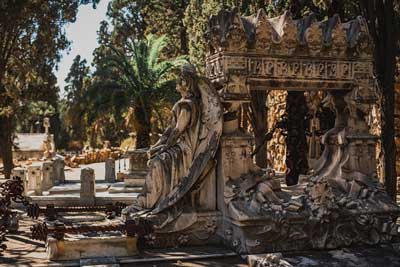
Gardens in Montjuïc
Due to the improvements made to Montjuic in preparation for the 1929 World Exhibition, you may now take leisurely strolls around several of its lovely gardens. In terms of their vegetation and architectural features, they are all fairly unique and each has its own traits.
You may consequently come across a garden while strolling through Montjuc that mainly features cacti (as at the Jardè de Mossèn Costa I Llobera) or one that was created to complement the palace housed there, the Palauet Albéniz (in the Joan Maragall gardens).
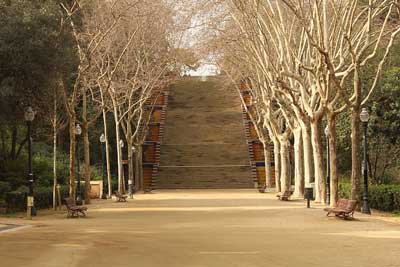
Other places of interest within Montjuïc
If the cultural and touristy attractions aren’t enough to pique your interest, we should let you know about some more mountainside beauties that are comparatively undiscovered and that we welcome you to explore.
Among the numerous examples, we would like to draw your attention to historical sites like the Venetian Towers, the Four Columns of Josep Puig I Cadafalch, the Teatre Lliure theater, the modernist, neoclassical, and gothic mausoleums located in the Montjuc Cemetery, as well as many others like the Communications Tower, the Mercat de les Flors (flower market), the Montjuc Lighthouse, and the magnificent monumental fountain in the You can also tour a Spanish-era air raid shelter with a reservation.
Map and how to get to Montjuïc
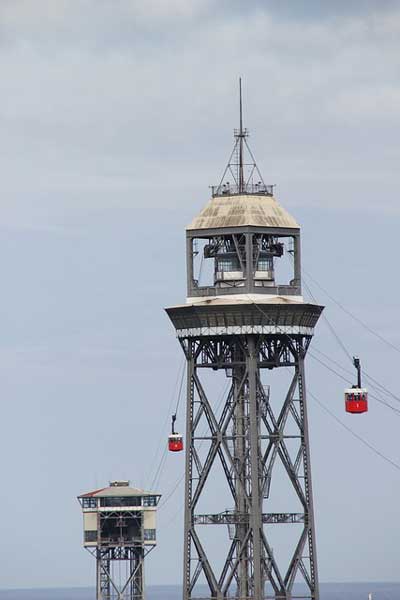
From some parts of the city, you can walk a short distance or use the Metro, bus, funicular, cable car, private automobile, or any of these modes of transportation to get there. You’ll need to choose which mode of transportation is most practical for you based on where in the city you’re traveling from and the purpose of your trip to the mountain.
The following are the easiest and most popular methods to go to Montjuc on foot; however, there are many other options.
- Plaça Espanya and the surrounding areas
- The Avinguda Maria Cristina, which will take you up to the Montjuc Fountain and the Palau Nacional, is the most convenient route to take when traveling on foot from Plaça Espanya and its neighboring regions. Another choice is to ascend Carrer Lleida, from where you can access the mountain via the gardens of the Teatre Grec.
- From the end of La Rambla and the surrounding areas
- You can ascend Montjuic Mountain on foot in about 15 minutes, starting from the end of La Rambla (near the statue of Christopher Columbus). You have two options for getting to the Jardins de Mossèn Costa i Llobera: either ascend the Passeig de Montjuc and then proceed up the Paseig de Miramar, or ascend the Forestier steps next to the Passeig de Josep Carner.
- Metro
- Depending on where you’d like to start your trip around the mountain, one of the following Metro stops will be more convenient for you, and you’ll need to choose between them:
- Espanya: Lines 1 and 3.
- Parallel: Lines 2 and 3.
- Poble Sec.: Line 3.
- Bus
- Lines: 13, 21, 23, 55, 64, 91, 125, 150, H12, D29, and the tourist bus.
- Out of all the buses, the only one that actually takes you right up to the top of Montjuïc, next to the castle, is the 150.
- Funicular
- You catch the funicular at Paral·lel metro station (Lines 2 and 3), and you can go up the mountain using the same public transport metro ticket. The funicular stops at Avinguda de Miramar, very close to the gardens of Mossèn Cinto Verdaguer and Joan Brossa.
- Aeri del Port cable car
- The Aeri del Port is the tourist attraction that takes you from the Sant Sebastià tower, in La Barceloneta, to the Jardins de Miramar in Montjuïc.
- Private vehicle
- If you want, you can go up Montjuïc in the car or on a moped, and there are various areas in which you can park including right at the top of the mountain by the castle.
Hotels around Montjuïc
There’s only one hotel a top Montjuïc Mountain itself, the Hotel Miramar, which is located in the Jardins de Miramar. At the base of the mountain and in its neighborhood (the Sants Montjuc and Poble Sec districts), there are alternative lodging possibilities.
When compared to neighborhoods in the city’s Old Town, such as El Raval and the Gothic Quarter, this neighborhood may not be the most central, but it is actually a great place to stay because there are a lot of tourist attractions nearby and a ton of bars and restaurants, many of which are in the Carrer Parallel and the Carrer Blai.
You may possibly walk to well-known attractions like the Passeig Martim promenade and La Rambla depending on where you are staying. The region is well served by Barcelona’s public transportation system, with Metro stations and bus stops that will swiftly and efficiently transfer you to other areas of the city, even though these are not quite within walking distance.
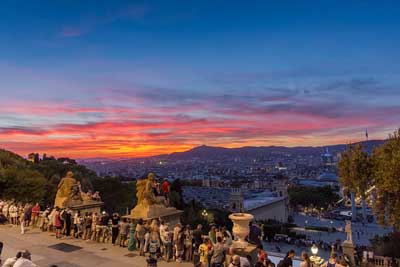
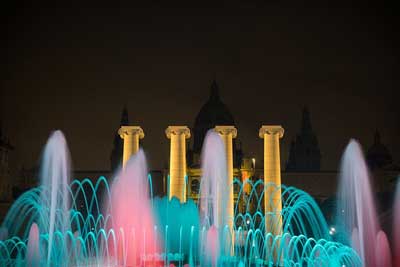
Bars, restaurants and nightlife in the area
With a variety of taverns and eateries that specialize in various cuisines, the Poble Sec neighborhood next to Montjuc has a lot to offer in terms of food and drink. You can have a famous aperitif at one of the local establishments (such as Celler Cal Marino, Bar Seco, Quimet I Quimet, etc.), eat pinchos at La Tasqueta de Blai, Blai 9, Blai Tonight, or go out to dinner in one of the several establishments on the bustling Carrer Blai (street). There are various bars and restaurants where you may have lunch or dinner at the Las Arenas retail center gardensGardens, stand out for their amazing views and their excellent food, respectively. There are also a lot of little cafés with outdoor terraces in the mountain.
The El Molino theater, which hosts cabaret acts and evening performances, the Sala Apolo, a popular nightclub in the Poble Sec neighborhood, and La Terrrazza, a nightclub within Poble Espanyol that opens its doors in the summer with the arrival of the good weather and has a sizable outdoor terrace, are some of the best places to spend the evening in the area.
Special events in Montjuïc
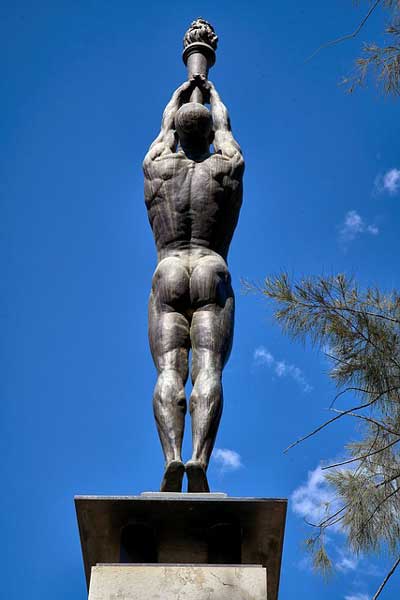
Montjuc Mountain is chosen as the location for the celebration of many events because it provides such a magnificent backdrop. Some of thents began as modest local endeavors but, as a result of their success, have grown into highlights of mountainsgardens. ndar for Barcelona’s locals and are also attended by many tourists.
Brunch -in The Park
Outdoor electronic music festival.
Sundays from June to September.
Joan Brossa Gardens.
More about experiences mountain in Barcelona…
[the-post-grid id=»759″ title=»PYRENEES & Natural Parks»]